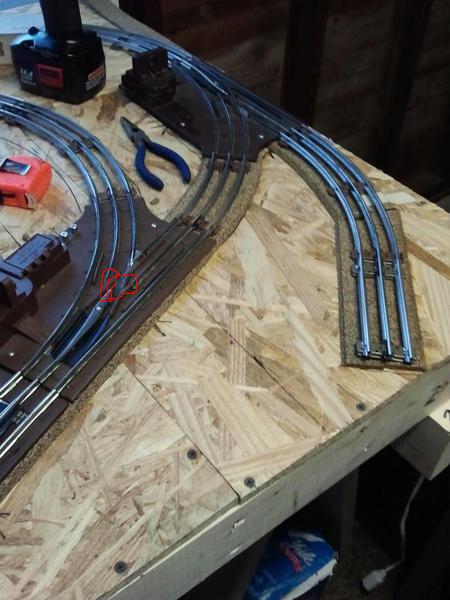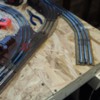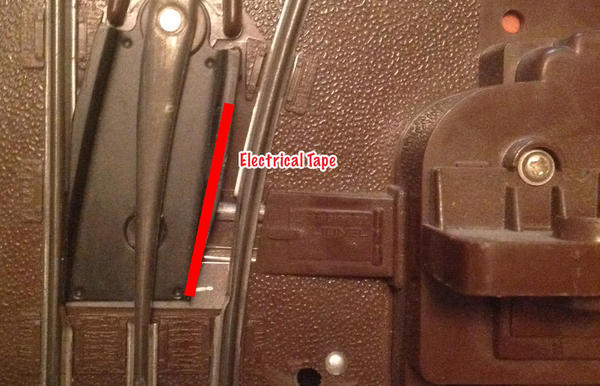So I built a small 3x5 layout in my apartment. Everything was working quite beautifully. Then I moved, had it storage for a year. Got it out of storage and thoroughly cleaned everything(also was wrapped). Now my train stops in the middle of all my switches. Pushed a lighted caboose over it. Looks like where the problem is, is when the track splits into two. So what's going on?
Replies sorted oldest to newest
Are the insulating pins in the proper rails? Do the switches operate properly when you move the switch controller? Does the non-derail function work on the switches? Are both legs of the switch dead? It seems all your switches have the same problem?
Larry
Yes the insulating pins are in the proper rails. The non-derail function does work.
Cleaned the rollers and cleaned all the tracks
Do you get a loss of power only at a certain spot on the switch, or on the entire section of rails after the swivel points?
Loss of power is only at a certain point. When I rolled my lighted caboose over it, it looks like its right where the track "forks" into two.
Here is a picture taken from one of your previous posts. The red areas circled near the swivel rail is the only place you should observe a loss of power. This is normal.
How many pick up rollers does your locomotive have?
Larry
Attachments
Which locomotive?
I have two pick up rollers on all my locomotives. That is the area, that when I rolled my lighted caboose that is loss of power. To ADCX Rob, its both my locomotives.
You may want to give this a try and see if it corrects the problem.
Curt
It is normal to experience a loss of power at this point on all switches. That is the way all switches are designed. While rolling through a switch at normal speed, there will be a momentary flicker in the light of your caboose. This is normal. Your locomotive should not experience any stalling on the switches if both rollers are picking up power properly. The locomotive should roll right through with no problem, and your caboose light should just flicker for a moment.
If your locomotive stops on the switch at normal speed, then there may be a problem with one of the rollers not picking up power properly. One thing that needs to be done is to clean the wheels and both pickup rollers on the locomotive if you have not done so already.
Which locomotive do you have, with the cab number and product number if possible?
Larry
Im sorry, im looking at my switch.....I don't understand. The black "switch" part.
RMT Beeper Bangor/Aroostook #64
Larry, when train stops. The first roller ends up on the area you circled.
The problem is, then, the other roller. It's either losing contact with the center rail or the connection to the roller has been compromised.

Its a brand new diesel. Only ran it a few times for a few hours at least
Any way I can find out if that's the problem.
A couple of questions........where exactly do you have your plastic pins located? And secondly, do you have a voltmeter? Can you measure the voltage in the three areas of the switch....each side of the frog on the straight and the far side of the frog on the turnout? Should be the same for all of them.
As for the contact of a wheel on the frog. Doesn't seem to be the same issue. I just spent 2 hours trying to track down the source of sparking on my 736 going through one of my switches (O27). I knew if was the front pilot but couldn't figure out what was contacting. Turns out it was the inside of the right wheel on the tip of the frog. A little electrical tape just solved it. However....that issue caused sparking, not stopping
Roger
Roger, the insulating pins are in the inside rails, per the instructions. I do have a voltmeter and that is bugging me. I found nothing wrong.
Where did you put the electrical tape?
Bluesheep,
I put a strip of tape (about 1/2 inch long, more or less) starting at the tip of the frog and moving away. Only on the side of that center rail part of the frog, so it doesn't interfere with the roller connection. When your engine stopped, did you get sparks first? If you're getting power to the turnout side, then track power is not the issue. It's strange that it was working before and not now. But I believe you said it was ALL of your switches. In which case I'm agreeing with Rob that it's a roller issue. See if you get any sparking before it stops.
Roger
Can you do a continuity test with your meter? A lead on each roller.
Roger
Im sorry, im looking at my switch.....I don't understand. The black "switch" part.
The black part is the swing rail. It delivers power too. There are small portions of track rails molded in plastic. Wide "V"s, maybe 1"x 1/2" long, x2 of them , those do not deliver power.
Its a brand new diesel. Only ran it a few times for a few hours at least
I think you should shine the tops of those rails more with Scotchbrite, and then check pin crimps better first. But it could maybe be the internal connections are now weaker. Other trains have no issues, and no signs of shorts right, just stopping and the caboose stays lit, no breaker trips. right?. Did you oil the roller? Some oils will interfere with contact, and/or collect "dirt". Do you have an ohm meter to poke at the rollers with? And do you have a electrical contact cleaner? Try cleaning the roller & axle too. Could be a lot of gunk stuck there from the initial "break-in period" too.
Bluesheep,
I put a strip of tape (about 1/2 inch long, more or less) starting at the tip of the frog and moving away. Only on the side of that center rail part of the frog, so it doesn't interfere with the roller connection. When your engine stopped, did you get sparks first? If you're getting power to the turnout side, then track power is not the issue. It's strange that it was working before and not now. But I believe you said it was ALL of your switches. In which case I'm agreeing with Rob that it's a roller issue. See if you get any sparking before it stops.
Roger
There was sparking before, but not any more
Can you do a continuity test with your meter? A lead on each roller.
Roger
I can not.
Bluesheep,
I put a strip of tape (about 1/2 inch long, more or less) starting at the tip of the frog and moving away. Only on the side of that center rail part of the frog, so it doesn't interfere with the roller connection. When your engine stopped, did you get sparks first? If you're getting power to the turnout side, then track power is not the issue. It's strange that it was working before and not now. But I believe you said it was ALL of your switches. In which case I'm agreeing with Rob that it's a roller issue. See if you get any sparking before it stops.
Roger
Did the strip of tape, still happening
When you say "before", does that mean before you had a problem with the engine stopping or as a result of something you did to fix it? And was the sparking in the area of that fat center rail? Sometimes you can see exactly where the sparking occurs by looking for pitting on the rail (or someplace on the engine as well). If the roller is contacting a rail other than the center, there will be pitting there. And it will stop the engine.
Roger
If you can't do a continuity test then connect a wire from the transformer to a roller and the other wire to the frame or a wheel. Should provide power to the engine. Then try the other roller. If both get and provide power, then they are working properly unless the spacing between them is a problem. If you run the engine at higher speed, will it blow through the switch without stopping?
Roger
When you say "before", does that mean before you had a problem with the engine stopping or as a result of something you did to fix it? And was the sparking in the area of that fat center rail? Sometimes you can see exactly where the sparking occurs by looking for pitting on the rail (or someplace on the engine as well). If the roller is contacting a rail other than the center, there will be pitting there. And it will stop the engine.
Roger
When I mean before(before I moved). It was sparking in the fat center rail. Short tip is all pitted and discolored. And that goes for all my switches. I don't see any pitting on the train itself though.
RMT Beeper Bangor/Aroostook #64
The RMT Beeps always gave me trouble on O27 switches. Spacing of the rollers and the way they tracked around that curve was to blame. I tried taping off parts of the switch which helped, but ultimately I just gave up on using the switches with the Beeps.
If you can't do a continuity test then connect a wire from the transformer to a roller and the other wire to the frame or a wheel. Should provide power to the engine. Then try the other roller. If both get and provide power, then they are working properly unless the spacing between them is a problem. If you run the engine at higher speed, will it blow through the switch without stopping?
Roger
Low or High speed....stops dead in its tracks(or on its tracks..lol)
abbrail,
That's what it's sounding like. I've read about the narrow spacing of those RMTs. 027s are kind of funky to start with and have all sorts of idiosyncrasies. So, if the rollers are too close together, it will stop.
Brian,
Do your other engines go through ok? is it just an issue with the RMT?
Roger
abbrail,
That's what it's sounding like. I've read about the narrow spacing of those RMTs. 027s are kind of funky to start with and have all sorts of idiosyncrasies. So, if the rollers are too close together, it will stop.
Brian,
Do your other engines go through ok? is it just an issue with the RMT?
Roger
I have an old post-war from the 50s, but that doesn't even run well on the tracks alone. That's why I went for the RMT, in my price range and it had my road name to boot.
Can I change the spacing with, like, from another train. If that's the problem.
Brian,
Something I'm not getting here........you said before you moved everything worked properly. Are you saying that you were using this RMT before the move and it worked fine through the switches and now it doesn't?
Roger
Had a couple of good runs before the move. Started back up after getting settled, and issues. Made my 3 year old kind of bummed(and her father)
Bluesheepbrian, It's been a while since I looked at what was causing my issues so I had to just pull out a Beep and an O27 switch to play around a bit. This may not be all of your issue, but the rollers on a Beep strike the outside rail as they pass through the switch. It's at the spot I've circled. In fact you can see some damage on my switch that was probably caused but the rollers making contact.
This obviously shorts everything. Move fast enough, which beeps aren't really good at, and you might glide past it and keep going.
My temporary solution was to put electrical tape over that rail. It allowed the beep to get through without the sparks.
Attachments
abbrail, if the beep just fast enough, your solution worked. Thanks. Have to play with it, but at least im on the right track.
abbrail,
Funky switches combined with a funky RMT. Tough combo. I've got a couple of MTH engines that stop on my switches (my other MTH ones are fine with them). I'm convinced that the pulse from the anti-derail circuit when the train hits the switch causes them to stop. My solution was to put toggles on the power going to the switches (they are wired for separate fixed voltage). When I run those engines, I use the toggles to cut the power and they don't stop. You do what you have to do with these crazy things.
Roger
Here is a link to my post on repairing 1122 switches: http://www.modeltrainforum.com/showthread.php?t=4142
In order to make these switches work properly, you have to remove the bottom cover and solder all the crimp connections. The crimp connections get loose as the switch ages due to the plastic cold flowing. When I wrote this post, I did several switches, and they all needed fixing.










